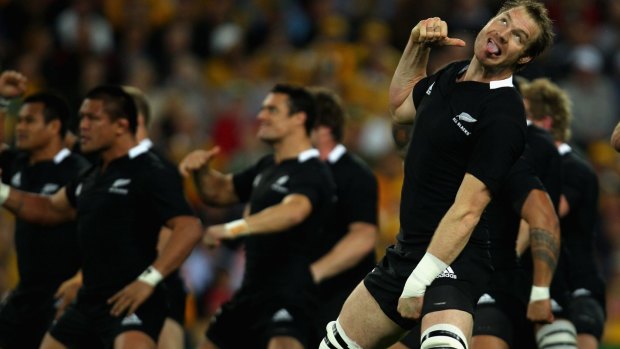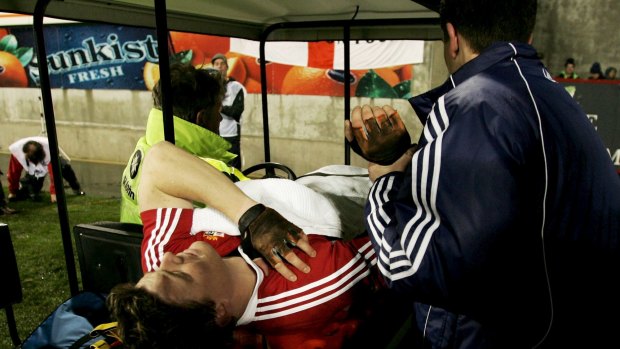This was published 10 years ago
The haka is a circus when the challenge cannot be returned
By Oliver Brown
To grasp the anomalousness of the haka, it helps to transplant it beyond a rugby context. Take the United States basketball team's recent World Cup match against New Zealand, the wonderfully named 'Tall Blacks'. The expression on the faces of Derrick Rose, Kyrie Irving et al as the ancient tribal dance unfolded in front of them spoke not of quavering fear, or steely let's-see-what-you've got defiance, but utter befuddlement. They could not have looked any more perplexed than if they had just been treated to an a cappella rendition of Yankee Doodle by Dame Kiri Te Kanawa.
The blank response was not quite what the Kiwis had in mind. For, if nothing else, the haka is orchestrated to stoke fear in the breast of an opponent, thus eking out a priceless early psychological advantage.
It is meant, as the throat-slitting gesture sometimes used as a final flourish makes abundantly clear, to be a declaration of war. But if all it elicits in the uninitiated is blank incredulity, then what is the point?
Increasingly, the ritual is drifting from any kind of sporting relevance, becoming instead a theatrically-rendered cultural curiosity. It will trigger the usual paroxysms of excitement at Twickenham on Saturday - and it is, I confess, sterling entertainment - but we are suckers for the choreography rather than the message it sends.

The throat-slitting gesture in the Kapa o Pango is a Maori symbol of drawing energy into the body.Credit: Getty Images
One might argue that the acrobats of Cirque du Soleil could induce much the same reaction, just without the contorted faces.
I realise that every Maori curse in the book will be arrayed against me for the cheek of that comparison. For the All Blacks regard their beloved haka with the utmost reverence, as a sacrosanct ancestral performance, rousing the players into a frenzy for the realities of impending conflict.
Given that it has been included in New Zealand rugby internationals since 1888, they reserve their right to stage it with uncommon ferocity. But when 15 savage men in black are threatening to cut your throat - and this is certainly how the Kapa o Pango haka appears, regardless of composer Derek Lardelli's insistence that the offending motion is a Maori symbol of drawing energy into the body - it ought also to come with the right to reply.
The trouble is that whenever the opposing team invoke this, it leads to the most frightful diplomatic mess. At the women's World Cup in 2010, the Australians dared to advance on the haka by a few half-hearted steps and were fined £1000 by the International Rugby Board. Granted, Richard Cockerill looked like an idiot when he went nose-to-nose with Norm Hewitt at Old Trafford in 1997, but he resented, understandably, the notion that he should just stand there like a lemon while a presumptuous Kiwi signalled the desire to tear him limb from limb.

Brian O'Driscoll, the Lions captain, is carried off the field after dislocating his right shoulder against the All Blacks in 2005.Credit: Getty Images
Taking a righteous stand never works, though, where the haka is concerned.
The Welsh Rugby Union tried it in 2006, demanding that the All Blacks should ensure the dance was all over and done with by the time Land Of My Fathers was heard. This, after all, is how it is supposed to be: the visitors deferring to the hosts, accepting that the Welsh have the prerogative to put their own anthem on last.
Instead New Zealand, with that strange air of entitlement, threw a spectacular fit of pique, refusing to conduct the haka on the field and agreeing only to release a video of them doing so in the dressing room.
A sense built that the haka was, when all the earnestness about its symbolism was stripped away, merely a form of arrogant machismo. For it stands alone in sport as a unilateral statement of intent, to which no challenge is permissible.
Again the All Blacks complained loudly when the Welsh decided, in 2008, that the best riposte to the haka was to stand motionless and stare. This, too, was depicted as a grotesque insult to their heritage.
All of which begs the question: what exactly is the right way to react to such a provocative call to arms?
Brian O'Driscoll ventured this very point when he was made Lions captain in New Zealand in 2005, and was told gravely by Maori elders that his best course of action was to toss a few blades of grass in the air. Well, that did him the power of good.
Fifteen minutes later he had his shoulder dislocated in an illegal spear tackle and was ruled out of the entire tour.
The haka, sadly, is hidebound by political correctness, such is the terror at executive level of offending the world's No.1 side. The IRB is even understood to have protocols decreeing that the All Blacks' adversaries should not encroach within 10 metres of the venerable act.
It all adds to the suspicion that the haka is, for all its vibrancy as a spectacle, scarcely more than a circus display these days. For England's players on Saturday, the temptation must be to follow the example of Australian great David Campese, who would absent-mindedly kick a ball around in his own 22 while the haka blew itself out.
Its sheer stage-management is of a piece with the creeping commercialisation of the All Blacks - what better way to beguile an American audience, or to satisfy shirt sponsors AIG at the match they mandated in Chicago last weekend, than with a mass war cry?
Most would-be converts in the United States, however, seem to share their basketball stars' view. Namely, that the haka is now less a part of the sporting fabric than an exotic sideshow.
The Telegraph, London